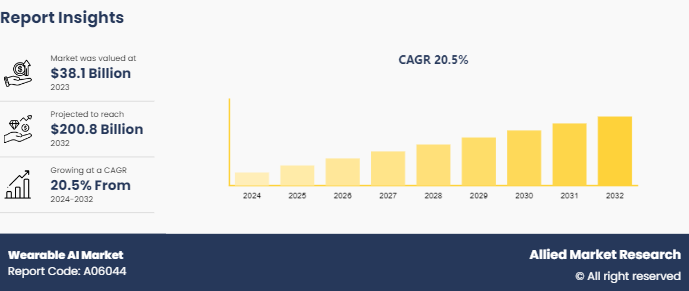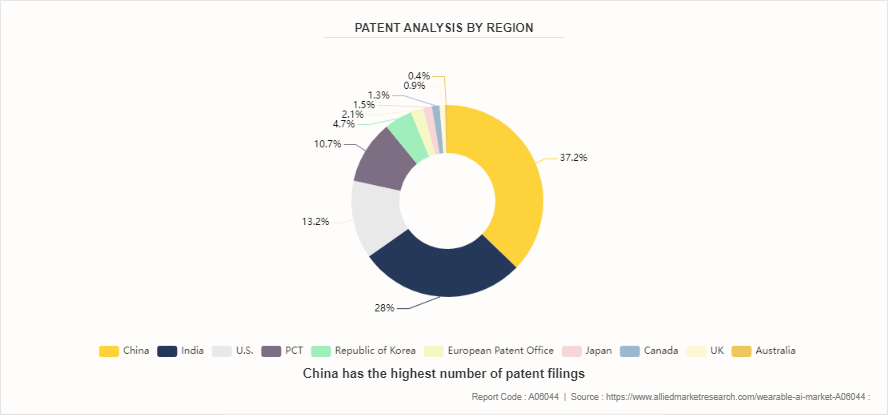Wearable AI Market Research, 2032
The global Wearable AI Market was valued at $38.1 billion in 2023, and is projected to reach $200.8 billion by 2032, growing at a CAGR of 20.5% from 2024 to 2032.

Market Introduction and Definition
The Wearable AI Market is focused on the development, production, and sale of wearable devices that incorporate artificial intelligence capabilities. This market is driven by rise in demand for devices that offer advanced functionalities beyond simple data collection, such as real-time data analysis, predictive insights, and personalized user experiences. Wearable AI devices include smartwatches, fitness trackers, smart glasses, and even AI-powered clothing, all designed to be worn on the body. These devices leverage AI algorithms to process and interpret data collected from various sensors, providing users with actionable insights related to health, fitness, and lifestyle. The market is characterized by rapid innovation and growth, fueled by advancements in AI technology, miniaturization of electronic components, and rise in consumer awareness and adoption of smart wearable technology.
Also, the integration of wearable AI with other smart devices and systems, such as smartphones and smart home technologies, is enhancing their appeal and functionality. This market is expanding in terms of consumer electronics as well as finding applications in sectors such as healthcare, sports, and enterprise solutions, where the ability to monitor, analyze, and act on real-time data is crucial. As a result, the wearable AI market is poised to significantly impact various aspects of daily life and industry practices.
Key Takeaways:
- The wearable AI market study covers 20 countries. The research includes a segment analysis of each country in terms of value for the projected period.
- More than 1, 500 product literatures, industry releases, annual reports, and other such documents of major wearable AI industry participants along with authentic industry journals, trade associations' releases, and government websites have been reviewed for generating high-value industry insights.
- The study integrated high-quality data, professional opinions and analysis, and critical independent perspectives. The research approach is intended to provide a balanced view of global markets and to assist stakeholders in making educated decisions to achieve their most ambitious growth objectives.
Industry Trends:
- In March 2024, the Department of Health and Social Care & Medicines and Healthcare products Regulatory Agency declared the investment of around $12.5 million in AI and medical devices. The funding supports eight tech companies developing devices with the potential to improve outcomes for patients of Alzheimer’s, stroke, cancer, and more.
- In March 2023, the European Union announced the investment of around $195 million in a Horizon Europe Programme that improves collaborative research and development across the Union. Artificial Intelligence, new materials, and robotics are among the key technologies for Europe’s transition to a digital, sustainable, and inclusive future.
Key Market Dynamics
The wearable AI market is propelled by the growing consumer demand for health and fitness monitoring. As individuals become more health-conscious, wearable AI devices offer advanced capabilities such as heart rate monitoring, sleep tracking, and personalized fitness recommendations, making them highly attractive. Technological advancements in AI and sensor technology are also crucial, enabling more accurate data collection and sophisticated data analysis, thus enhancing the functionality and appeal of these devices. The proliferation of smartphones and improved internet connectivity facilitates seamless integration and data synchronization, further boosting the usability and attractiveness of wearable AI.
Also, rise in adoption of IoT (Internet of Things) technologies allows for more interconnected and responsive ecosystems, where wearable AI devices interact with other smart devices, enhancing the overall user experience. The COVID-19 pandemic has also accelerated the adoption of health-focused wearables as individuals seek to monitor their health more closely. Furthermore, rise in chronic diseases and the growing aging population are driving the need for continuous health monitoring, which wearable AI can effectively provide. Growing investments in R&D by tech companies and startups are leading to innovative products and applications, expanding the market’s potential, and encouraging more widespread adoption.
The wearable AI market faces challenges such as concerns over data privacy and security, which can deter consumers from adopting these devices. High cost of advanced wearable AI technology also poses a barrier, making it less accessible to a broader audience. In addition, limited battery life and the need for frequent charging hinder user experience and convenience.
Wearable AI can revolutionize patient care through continuous health monitoring, early disease detection, and remote patient management, reducing the burden on healthcare facilities and improving patient outcomes. Rise in prevalence of chronic diseases and the aging population further drive the demand for such health-focused wearables. Moreover, the integration of wearable AI with IoT and smart home technologies opens new possibilities for creating more personalized and interconnected living environments. The sports and fitness industry also benefits from wearable AI, with devices providing detailed performance analytics and personalized training programs, enhancing athletic performance and fitness regimes.
Also continued advancements in AI and wearable tech, coupled with decreasing production costs, are likely to make wearable AI devices more affordable and accessible, expanding their adoption and driving market growth.
Patent Analysis of Wearable AI Market
The global wearable AI industry report is segmented according to the patents filed in the China, India, U.S., PCT, Republic of Korea, European Patent Office, Japan, Canada, UK, and Australia. China has the largest number of patent filings, owing to suitable research infrastructure. Approvals from these authorities are followed/accepted by registration authorities in many of the developing regions/countries. The patents registered by these countries are from 2015 to 2023.

Market Segmentation
The wearable AI market analysis is segmented into type, operation, application, and region. On the basis of type, the market is divided into smartwatches, smart eyewear, smart earwear, and others. By operation, it is divided into on-device AI and cloud-based AI. On the basis of application, the market is categorized into consumer electronics, healthcare, automotive, military and defense, media and entertainment, and others. Region-wise, the wearable AI market trends are analyzed across North America (U.S., Canada, and Mexico) , Europe (Germany, France, Italy, UK, and rest of Europe) , Asia-Pacific (China, Japan, India, South Korea, and rest of Asia-Pacific) , and LAMEA (Latin America, Middle East, and Africa) .
Regional/Country Market Outlook
North America held the highest market share in the wearable AI market in 2023 and is expected to continue its dominance during the forecast period. The region's advanced technological infrastructure and high adoption rate of innovative technologies are important factors for the growth of the wearable AI market. In addition, the strong presence of major tech companies and startups driving innovation in wearable technology significantly contributes to market leadership. The increasing consumer demand for health and fitness monitoring devices, fueled by growing health consciousness and the prevalence of chronic diseases, further propels the market. Moreover, substantial investments in research and development by both public and private sectors enhance the capabilities and applications of wearable AI devices. North America's favorable regulatory environment and well-established healthcare system also support the widespread adoption of these advanced technologies, ensuring the region continues to lead in the wearable AI market.
Competitive Landscape
The wearable AI company list includes TOMTOM INTERNATIONAL B.V., Amazon.com, Inc., Motorola Mobility LLC (Lenovo), SAMSUNG ELECTRONICS CO. LTD., Garmin Ltd., International Business Machines Corporation (IBM), Fitbit, Inc., Google Inc. (Alphabet Inc.), Huawei Technologies Co. Ltd., and SONY CORPORATION. These key players have adopted strategies, such as product portfolio expansion, mergers & acquisitions, agreements, geographical expansion, and collaborations, to enhance their market penetration.
Recent Key Strategies and Developments
- In January 2024, Xiaomi launched Redmi Buds 5 and Redmi Buds 5 pro, both equipped with active noise cancellation.
- In May 2022, IBM announced a strategic collaboration agreement with Amazon Web Services (AWS) . This partnership allowed IBM to offer a range of its software products as services on the AWS marketplace. Both companies made investments to help businesses utilize IBM's services and integrate them with AWS effectively.
Key Sources Referred
- Association for the Advancement of Artificial Intelligence
- International Artificial Intelligence Industry Alliance
- The AI Association
- Asia-Pacific Artificial Intelligence Association
- Indian Society of Artificial Intelligence and Law
- A3 Association for Advancing Automation
- European Association for Artificial Intelligence
- Shanghai AI Industry Association
Key Benefits For Stakeholders
This report provides a quantitative analysis of the market segments, current trends, estimations, and dynamics of the Wearable AI market forecast from 2024 to 2032 to identify the prevailing wearable ai market opportunities.
The market research is offered along with information related to wearable AI growth drivers, restraints, and opportunities.
Porter's five forces analysis highlights the potency of buyers and suppliers to enable stakeholders make profit-oriented business decisions and strengthen their supplier-buyer network.
In-depth analysis of the wearable ai market segmentation assists to determine the prevailing market opportunities.
Wearable AI market size by country in each region are mapped according to their revenue contribution to the global market.
Market player positioning facilitates benchmarking and provides a clear understanding of the present position of the market players.
The report includes the analysis of the regional as well as global wearable ai market trends, key players, market segments, Wearable AI market share by companies, application areas, wearable AI market value, smart wearables, activity tracking, wearable AI market insights, and wearable AI market growth strategies.
Wearable AI Market Report Highlights
| Aspects | Details |
| Market Size By 2032 | USD 200.8 Billion |
| Growth Rate | CAGR of 20.5% |
| Forecast period | 2024 - 2032 |
| Report Pages | 259 |
| By Type |
|
| By Operation |
|
| By Application |
|
| By Region |
|
| Key Market Players | Garmin Ltd, Sony Corporation, SAMSUNG ELECTRONICS CO. LTD, Huawei Technologies Co. Ltd., TOMTOM INTERNATIONAL B.V, Amazon.com, Inc, Google Inc., Fitbit, Inc., Motorola Mobility LLC, International Business Machines Corporation |
The wearable AI market was valued at $38.1 billion in 2023 and is estimated to reach $200.8 billion by 2032, exhibiting a CAGR of 20.5% from 2024 to 2032.
North America is expected to continue its dominance over the forecast period due to a robust technological infrastructure, significant investments in AI research and development, high adoption rates of advanced consumer electronics, and strong presence of key market players driving innovation and market growth in the region.
The global wearable AI market is driven by innovations in health monitoring, fitness tracking, and personalized recommendations. Key trends include the integration of AI for enhanced user experience, development of smart clothing, improved battery life, and increasing adoption in healthcare and sports industries for real-time data analysis and insights.
The key wearable AI market leaders profiled in the report include TOMTOM INTERNATIONAL B.V., Amazon.com, Inc., Motorola Mobility LLC (Lenovo), SAMSUNG ELECTRONICS CO. LTD., Garmin Ltd., International Business Machines Corporation (IBM), Fitbit, Inc., Google Inc. (Alphabet Inc.), Huawei Technologies Co. Ltd., and SONY CORPORATION.
By application, the consumer electronics segment held the highest market share in 2023 and is expected to continue its dominance during the forecast period due to high demand for smart devices like smartwatches and earwear, advancements in AI technology, and growing consumer preference for integrated, multifunctional gadgets enhancing daily life and connectivity.
Loading Table Of Content...


